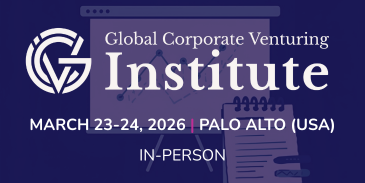Design the strategy from the ground up, find out what doors to knock on, and be quietly persistent.

A corporate venture capital fund’s main advantage is that is can offer a startup not just money but help and potentially a customer relationship with the parent corporation. But although corporations are keen to tap into the innovation of startups, it is not always easy to broker that collaboration.
So how best to maximise the chance of getting the two sides working together?
Start with the design
How you structure your investment programme in the first place will determine much of the success you have onboarding startups down the line. In theory, if you set it up to solve for the specific problems BUs are facing, the pull factor will be largely built-in.
“For me, successful portfolio collaboration starts with being hyper clear on why you invest and building a focus and thesis around that mission. Collaboration challenges are solved for at the thesis level,” says Oliver Fitz-Gibbon, head of platform at InMotion Ventures, the CVC unit of Jaguar Land Rover.
“We’ve spent a lot of time with people within the corporate, talking about their challenges, what they’re working on, where they’re innovating in-house, where the gaps are, and then building a thesis around that.”
CVCs that are highly focused on the strategic benefits of investing in startups will be under particular pressure to get projects going and finding a home at the parent company for the technology. Solving for the problem before investing is preferable to doing it afterwards, says Fitz-Gibbon. InMotion Ventures leans towards earlier stage investments and has virtually its entire portfolio in some form of collaboration with the parent.
Other car sector CVCs — such as German carmaker BMW’s iVentures investment unit — do it differently. IVentures often invests at a much later stage and with more of a financial objective than InMotion. One of the first things that happens after iVentures invests, is a kick-off meeting to see where the startup would be best placed. This is different from the meetings with the startup before investment, where the focus is chiefly on KPIs.
“In the kick-off meeting, we see what the strategy for the company is, where they want to go, and what their roadmap or future vision is. Then we align and see where the right point is to connect,” says Inga Grieger, business development manager at BWM iVentures.
Whereas a CVC like InMotion optimises for the pull factor, Grieger says that her work is roughly two-thirds pushing startups into the corporate. It is still crucial to have a clear path from those initial meetings, and looking out for pain points is a continuous job.
“A lot of the time, when something fails it’s less of an execution problem than a strategy problem. So perhaps the strategy for the project wasn’t set right at the beginning,” says Claire Dardignac, head of Europe at corporate innovation consultancy The Bakery.
At The Bakery, she explains, they make a point to involve all relevant stakeholders, especially the ones who have budget power, from the very beginning, and even build in periodic milestones when all stakeholders have to be in the same room to touch base and get to decisions faster.
Don’t put all your eggs in the (corporate) basket
“We see it time and time again – startups that get really frustrated about the fact that they’re not getting an answer to a very crucial question. Between the time that they first start interacting with a corporate and the time that they actually close something with them, it might be a year or 24 months. Within that timeframe, a startup runs the risk of going under and not getting to revenue,” says Dardignac.
Seed-stage startups, which may need commercial validation before they can raise a series A, can find this particularly frustrating.
“I encourage our portfolio and actively help our portfolio meet other corporates.”
Oliver Fitz-Gibbon, InMotion Ventures
“A challenge that startups should avoid is having all their eggs in one basket – in one corporate. Delaying milestones in anticipation of a specific partnership or collaboration is not without its risks,” says Oliver Fitz-Gibbon, head of platform at InMotion Ventures, the CVC unit of Jaguar Land Rover.
“That’s also the reason I encourage our portfolio and actively help our portfolio meet other corporates.”
A proof-of-concept (POC) may be the most important thing happening at a startup – and, by extension, in that founder’s life – but it is one among many priorities for the corporate, and not necessarily high on the list. Depending on the stage in the budget or planning cycle, priorities will wax and wane – if a lot of things internally come to a head at once, a startup can find its go-to person within the corporate unavailable and their project at the bottom of the list.
One of the roles of a CVC then is to be a translator between the two – yes the founder needs to be more patient, but the corporate needs to appreciate the urgency they operate with.
A savvy startup can leverage cycles in their favour, though. Towards the end of the year, for example, when departments are looking for ways to spend their remaining budget, founders can find opportunities to reach out and see what additional projects they can strike up.
In many cases, startups can also take advantage of pre-approved budgets for innovation in certain areas like AI, for example, according to Dardignac.
“For us, what that has looked like is ring-fencing the testing budget right at the start and holding it on behalf of the corporate, which means we’re able to release it quickly to the startups and we don’t have to go through a budget committee or for the typical 90-day payment terms because it’s essentially been pre-approved,” she says.
Don’t let them forget you
“There’s a massive education piece internally, even at a really basic level, about what venture capital is and what we do, as well as what we’re delivering to the rest of the business – making sure people know that this shiny new thing came from us. It’s kind of a flywheel effect,” says Emily Havers, platform manager at Fidelity International Strategic Ventures, the CVC arm of financial services provider Fidelity International.
Time and money spent preaching your gospel internally and showing the benefit you bring to the corporate strategy is time and money well spent.
“Having great relationships means we can get a really quick read on the excitement levels for a startup.”
Emily Havers, Fidelity International Strategic Ventures
The easiest successes you can show are financial – did this pilot show that it can make something cheaper or more efficient if scaled? Having an actual number is hugely helpful, but have other metrics you can point to, and make it widely known when you hit them. Always tie it back to the corporate strategy – does it help the corporate enter a new market segment they had their eye on? Does it bring them closer to hitting their 2030 targets?
Quality is often more important than quantity when building your internal networks. Relationships with senior people with clout, who can remove blockers, are worth their weight in gold. Also valuable are relationships with well-connected colleagues who have cross-function networks and can open doors across the business.
“Having great relationships means we can get a really quick read on the excitement levels for a startup, and whether people are twiddling their thumbs or coming away thinking there is real potential,” says Havers.
Procurement
For earlier-stage startups, the prospect of getting a full supplier contract with the corporate may fall out of reach, but there are ways around that. The collaboration can be defined more ambiguously – perhaps as a design partnership as opposed to a direct sale.
Later-stage companies will likely be competing via requests for proposals (RFPs) for contracts, where there is no guarantee they’re the best one for the award. Herein lies a challenge. Corporate procurement teams are, of course, mandated to save the company money and drive the price down, which can then harm a startup’s target profit margin.
There’s only so much a CVC can do to help a startup in the RFP phase, as they need a Chinese wall between the business and the venture side, but they can at least advise on what good looks like up to a certain point, while still avoiding conflicts of interest. Ultimately, the technology will have to speak for itself, but having good enterprise sales teams at the startups will go a long way.
It is worth having alternative routes that don’t just go through procurement, as falling at the RFP hurdle can also hurt a CVC’s basic value-add proposition of working with the corporate.
A company like BMW has the advantage of having an in-house venture clienting programme – BWM Startup Garage – through which the corporate can engage startups without the same procurement process. Beyond that, it might be the case that the value the CVC brings is to connect them with partners outside the corporate itself, but that can still indirectly sell into it.
“The OEM is not always the right customer for the startup. Sometimes you have applications that are better suited to parts that BMW procures from our first or second-tier supplier,” says Grieger.
Startups would also do well to do whatever they can to remove friction from the process.
“Make it easy to spend money with you,” says Dardignac. “Build the project plan or your proposal to the corporate into separate chunks, being extremely clear about where you will get to at what point. Your corporate champion has to show they’re doing what they can to manage risk, so it’s easier if you make it stage-gated and iterative, and set expectations around the level of validation you get to at each stage.”
Know the touchpoints
“Understand who genuinely gets innovation in the business. Not just who is an innovation tourist – which is a big problem – but who gets innovation, who’s interested or not, because there might be someone who is the perfect sponsor on paper, but they just don’t see the value in working with startups, and that’s fine. Don’t waste your time on that,” says Fitz-Gibbon.
Having a handle on who has budget is incredibly useful, lest the startup ends up doing a lot of work just to learn that the money is not there to see it through properly.
“Understand who genuinely gets innovation in the business. Not just who is an innovation tourist.”
Oliver Fitz-Gibbon, InMotion Ventures
Don’t underestimate the importance of corporate politics, either. Onboarding startup technology tends to mean displacing at least part of what an incumbent supplier is already doing. At a large corporate, these supplier relationships can be very strong and ingrained, often underpinned by relationships that may have even become personal for decision-makers. Keep those decision-makers involved in the process, though, as you don’t want their external relationships adversely affected by things suppliers may hear through the grapevine.
More fundamentally, not everyone in the company will appreciate that failure is okay – there will be a topography of risk appetites across any corporate.
Never forget that keeping an eye out for pain points is a perpetual activity. For an OEM like BWM, for example, it’s often easier to find a home for a technology that makes a process better, as opposed to one that will be eventually integrated into the car itself. The development process for a car can take around six or seven years, and any change will have knock-on effects down the line. People tend to be more resistant to going through an integration that will make an already complicated vehicle development that much more so.
On the other hand, if you’re talking about something that will improve a production facility, anything that could make even marginal improvements merits a look.
“The hurdles are very clear from a production perspective – there are so many clear KPIs you can fit a startup’s technology in. Just to save a second in a production line makes a new technology very attractive,” says Grieger.
For FISV, which prefers to lead or be a significant follower in deals, access goes a long way to finding where they can best onboard startups.
“We have access to the board, which – while maintaining strict Chinese walls between the business and the venture side – gives us enough insight and information to know how best to plug it into Fidelity,” says Erik Mostenicky, principal at FISV.
Consistency and risk-taking
Ultimately, you just have to keep plugging away at it and the right opportunity will come along.
“What I’ve learned over three years of doing this is that sometimes you need to fit into the right time point.”
Inga Grieger
“What I’ve learned over three years of doing this is that sometimes you need to fit into the right time point,” says Grieger “Sometimes you can really knock so many times on the doors and nothing happens, and then one day it will open in a way you can’t plan for. It’s good to stay consistent and try it again and again. But, of course, be mindful not to stress the other side as well.”
But you also need to be willing to take the fall.
“As the saying goes, no one gets fired for hiring IBM,” says Mostenicky.
“Having cultural or HR policies that reward people taking risks is important. If you don’t have a culture within the corporate that incentivises risk, taking on innovation and being bold, then it’s a question of time before a lot of businesses get disrupted.”

Fernando Moncada Rivera
Fernando Moncada Rivera is a reporter at Global Corporate Venturing and also host of the CVC Unplugged podcast.








